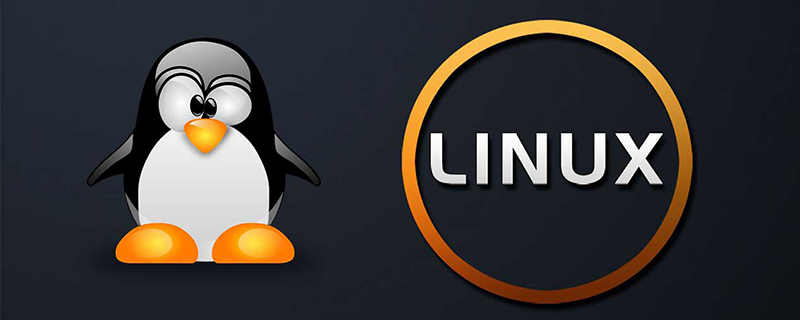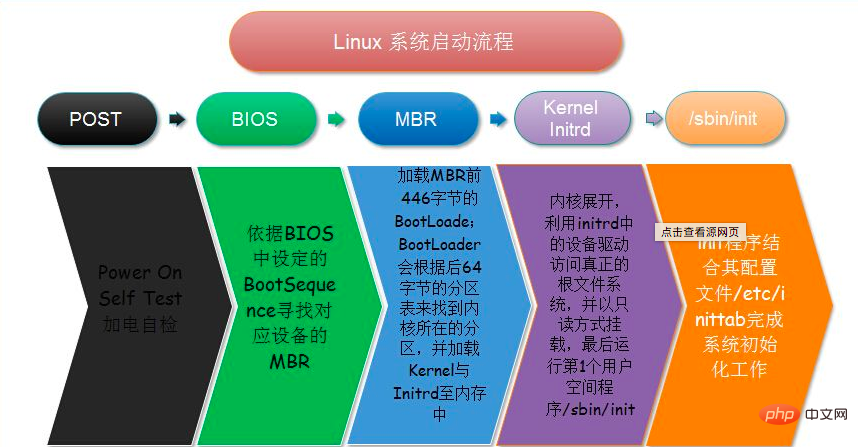linux boot sequence
The following will introduce you to the Linux startup sequence. For more Linux usage tutorials, please visit Linux Video Tutorial to learn!

Linux startup sequence flow chart:

The first step of startup - loading BIOS
When you turn on the computer power, the computer will first load the BIOS information, BIOS The information is so important that the computer must find it in the first place. This is because the BIOS contains CPU-related information, device boot sequence information, hard disk information, memory information, clock information, PnP features, etc. After this, the computer has a mental map and knows which hardware device it should read.
Start the second step - read MBR
As we all know, the first sector of track 0 on the hard disk is called MBR. That is, the Master Boot Record, the main
boot record, its size is 512 bytes, although the space is small, but it stores pre-boot information and partition table information .
After the system finds the MBR of the hard disk specified by the BIOS, it will be copied to the physical memory at the 0x7c00 address.
In fact, the content copied to the physical memory is Boot Loader, and specifically for your computer, it is lilo or grub
.
The third step of starting--Boot Loader
Boot Loader is a small program that runs before the operating system kernel runs. Through this small program, we can
initialize the hardware device and establish a map of the memory space, thereby bringing the system's software and hardware environment to a suitable state for the final call. The operating system kernel is ready for everything. There are several types of Boot Loaders, among which Grub, Lilo and spfdisk are common Loaders.
Let’s take Grub as an example. After all, not many people use lilo and spfdisk.
The system reads the grub configuration information in the memory (usually menu.lst or grub.lst), and
starts different operating systems based on this configuration information.
Start the fourth step - load the kernel
According to the path of the kernel image set by grub, the system reads Get the memory image and decompress it. At this time, the screen
will generally output the prompt "Uncompressing Linux". When the decompression of the kernel is completed, the screen outputs "OK,
booting the kernel". The system places the decompressed kernel in the memory and calls the start_kernel() function to start a series of initialization functions
and initialize various devices to complete the establishment of the Linux core environment . At this point, the Linux kernel has been established, and programs based on Linux should be able to run normally.
Start the fifth step--User layer init Set the running level according to the inittab file
After the kernel is loaded, the first run The program is /sbin/init, which reads the /etc/inittab file and performs initialization based on this file.
In fact, the main function of the /etc/inittab file is to set the running level of Linux. The setting format is ":
id:5:initdefault:", which shows that Linux needs Runs at level 5. The running level settings of Linux are as follows:
0: Shutdown1: Single-user mode
2: Multi-user mode without network support
3 : Multi-user mode with network support
4: Reserved, not used
5: Multi-user mode with network support and X-Window support
6: Reboot System, that is, restart
Start the sixth step - the init process executes rc.sysinit
After setting the running level, the Linux system The first user-level file executed is the /etc/rc.d/rc.sysinit script program. It does a lot of work, including setting PATH and setting network configuration (/etc/sysconfig /network), enable swap partition, set /proc, etc. If you are interested, you can check the rc.sysinit file in /etc/rc.d.
Start the seventh step--Start the kernel module
According to the /etc/modules.conf file or /etc/modules.d directory to load kernel modules. Start the eighth step--Execute script programs at different run levels
According to different run levels, the system will run the corresponding script programs in rc0.d to rc6.d to complete Corresponding initialization work and starting corresponding services.
Start the ninth step - execute /etc/rc.d/rc.local
If you open this file, there is a sentence in it. After reading it, you will The function of this command will be clear at a glance
rc.local is the place where Linux leaves the user with personalization after all initialization work. You can put what you want to set up
and start here.
Start the tenth step - execute the /bin/login program and enter the login state
The above is the detailed content of linux boot sequence. For more information, please follow other related articles on the PHP Chinese website!

Hot AI Tools

Undresser.AI Undress
AI-powered app for creating realistic nude photos

AI Clothes Remover
Online AI tool for removing clothes from photos.

Undress AI Tool
Undress images for free

Clothoff.io
AI clothes remover

Video Face Swap
Swap faces in any video effortlessly with our completely free AI face swap tool!

Hot Article

Hot Tools

Notepad++7.3.1
Easy-to-use and free code editor

SublimeText3 Chinese version
Chinese version, very easy to use

Zend Studio 13.0.1
Powerful PHP integrated development environment

Dreamweaver CS6
Visual web development tools

SublimeText3 Mac version
God-level code editing software (SublimeText3)

Hot Topics
 1387
1387
 52
52
 How to use docker desktop
Apr 15, 2025 am 11:45 AM
How to use docker desktop
Apr 15, 2025 am 11:45 AM
How to use Docker Desktop? Docker Desktop is a tool for running Docker containers on local machines. The steps to use include: 1. Install Docker Desktop; 2. Start Docker Desktop; 3. Create Docker image (using Dockerfile); 4. Build Docker image (using docker build); 5. Run Docker container (using docker run).
 How to view the docker process
Apr 15, 2025 am 11:48 AM
How to view the docker process
Apr 15, 2025 am 11:48 AM
Docker process viewing method: 1. Docker CLI command: docker ps; 2. Systemd CLI command: systemctl status docker; 3. Docker Compose CLI command: docker-compose ps; 4. Process Explorer (Windows); 5. /proc directory (Linux).
 What to do if the docker image fails
Apr 15, 2025 am 11:21 AM
What to do if the docker image fails
Apr 15, 2025 am 11:21 AM
Troubleshooting steps for failed Docker image build: Check Dockerfile syntax and dependency version. Check if the build context contains the required source code and dependencies. View the build log for error details. Use the --target option to build a hierarchical phase to identify failure points. Make sure to use the latest version of Docker engine. Build the image with --t [image-name]:debug mode to debug the problem. Check disk space and make sure it is sufficient. Disable SELinux to prevent interference with the build process. Ask community platforms for help, provide Dockerfiles and build log descriptions for more specific suggestions.
 What computer configuration is required for vscode
Apr 15, 2025 pm 09:48 PM
What computer configuration is required for vscode
Apr 15, 2025 pm 09:48 PM
VS Code system requirements: Operating system: Windows 10 and above, macOS 10.12 and above, Linux distribution processor: minimum 1.6 GHz, recommended 2.0 GHz and above memory: minimum 512 MB, recommended 4 GB and above storage space: minimum 250 MB, recommended 1 GB and above other requirements: stable network connection, Xorg/Wayland (Linux)
 vscode cannot install extension
Apr 15, 2025 pm 07:18 PM
vscode cannot install extension
Apr 15, 2025 pm 07:18 PM
The reasons for the installation of VS Code extensions may be: network instability, insufficient permissions, system compatibility issues, VS Code version is too old, antivirus software or firewall interference. By checking network connections, permissions, log files, updating VS Code, disabling security software, and restarting VS Code or computers, you can gradually troubleshoot and resolve issues.
 Can vscode be used for mac
Apr 15, 2025 pm 07:36 PM
Can vscode be used for mac
Apr 15, 2025 pm 07:36 PM
VS Code is available on Mac. It has powerful extensions, Git integration, terminal and debugger, and also offers a wealth of setup options. However, for particularly large projects or highly professional development, VS Code may have performance or functional limitations.
 What is vscode What is vscode for?
Apr 15, 2025 pm 06:45 PM
What is vscode What is vscode for?
Apr 15, 2025 pm 06:45 PM
VS Code is the full name Visual Studio Code, which is a free and open source cross-platform code editor and development environment developed by Microsoft. It supports a wide range of programming languages and provides syntax highlighting, code automatic completion, code snippets and smart prompts to improve development efficiency. Through a rich extension ecosystem, users can add extensions to specific needs and languages, such as debuggers, code formatting tools, and Git integrations. VS Code also includes an intuitive debugger that helps quickly find and resolve bugs in your code.
 How to back up vscode settings and extensions
Apr 15, 2025 pm 05:18 PM
How to back up vscode settings and extensions
Apr 15, 2025 pm 05:18 PM
How to back up VS Code configurations and extensions? Manually backup the settings file: Copy the key JSON files (settings.json, keybindings.json, extensions.json) to a safe location. Take advantage of VS Code synchronization: enable synchronization with your GitHub account to automatically back up all relevant settings and extensions. Use third-party tools: Back up configurations with reliable tools and provide richer features such as version control and incremental backups.




